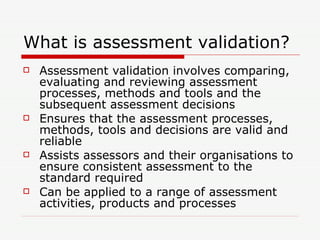Assessment Validation
- 1. What is assessment validation? Assessment validation involves comparing, evaluating and reviewing assessment processes, methods and tools and the subsequent assessment decisions Ensures that the assessment processes, methods, tools and decisions are valid and reliable Assists assessors and their organisations to ensure consistent assessment to the standard required Can be applied to a range of assessment activities, products and processes
- 2. Your role in assessment validation May include: Preparation Obtaining, reading and interpreting materials Submitting your materials Participating in assessment validation activities Discussing validation findings
- 3. AQTF and assessment validation Validation is part of an organisation’s quality processes – continuous improvement For RTO’s, it is a requirement of AQTF 2007 that The RTO collects, analyses and acts on relevant data for continuous improvement of training and assessment.
- 4. Assessment validation needs to be: A formalised process that is Planned Targeted at a specific audience Documented Focused on identified areas such as assessment methods and tools
- 5. Purposes of validation Demonstrate compliance with the AQTF standards for RTO’s Provide evidence for external and/or internal audits Improve assessment practices Evaluate the quality of assessment tools Provide professional development for assessors
- 6. Purposes of validation cont… Increase assessor and facilitator confidence Determine whether different assessors/facilitators using the same tools collect the same types and levels of evidence Determine whether different assessors/facilitators interpret the same evidence similarly Determine whether assessment decisions reflect the rules of evidence
- 7. Validation could identify whether: Assessment policies and procedures are effective and are being followed Candidates are receiving the kind of information they need about assessment Assessment resources are properly designed Assessors are assessing consistently
- 8. Materials Samples of assessments & assessment tools Evidence and assessment decisions Benchmark – Unit of Competency – performance criteria and range statements Evidence guide
- 9. Contributing to validation It is important to: Be prepared (pre-reading, making initial notes) Communicate openly Listen to other assessors Ask probing questions Check documentation for accuracy Contribute to the discussion Contribute to and clarify recommendations for improvement
- 10. Analysing and documenting validation What has been discovered? What are the recommendations for improvement? How will we document recommendations? What action/s will be taken as a result of assessment validation?









